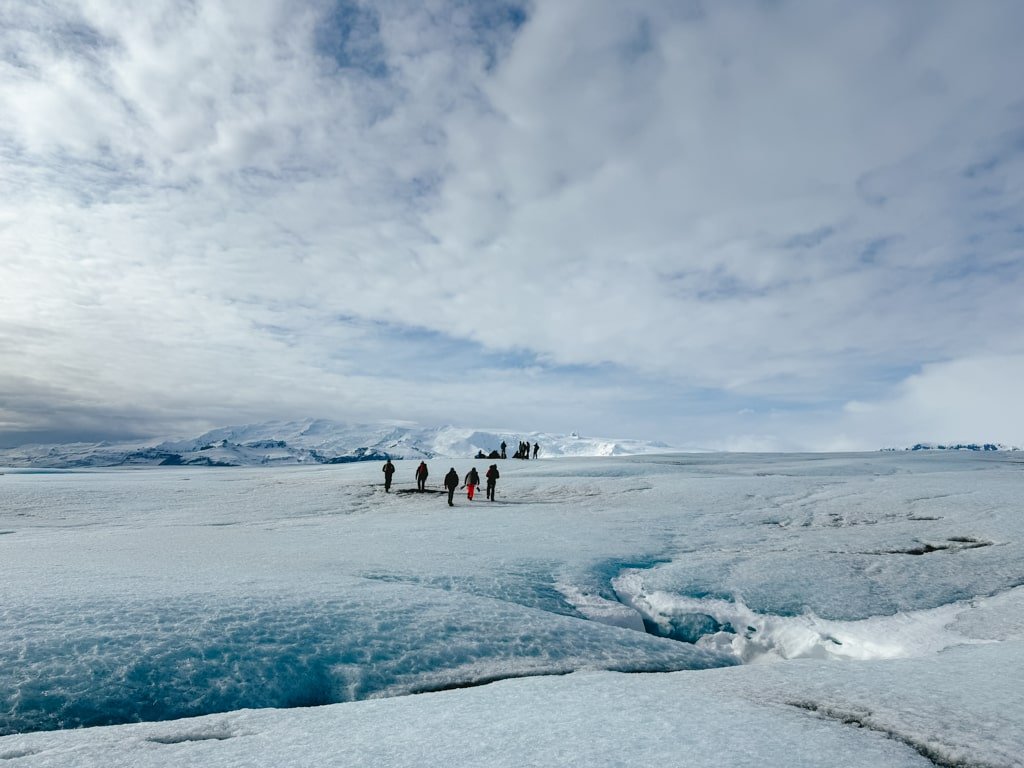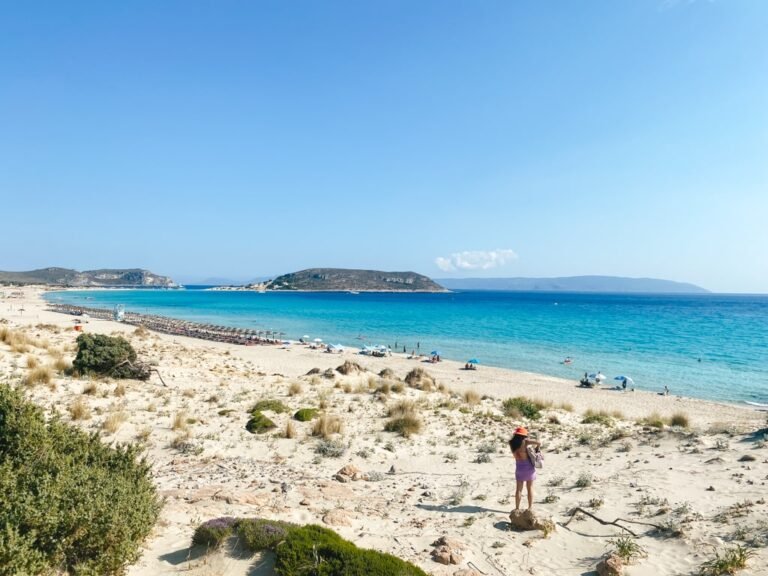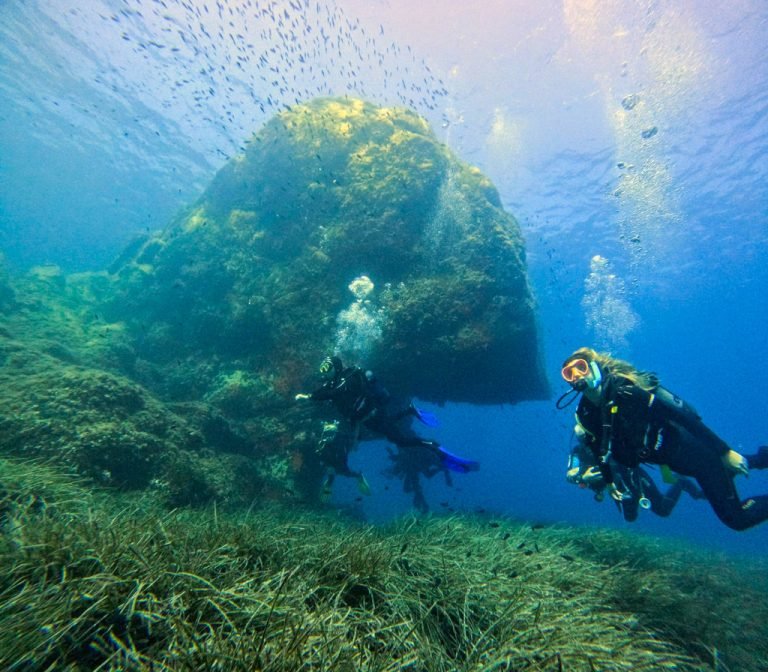This article may contain affiliate links. When you purchase something we recommend, we make a small commission. You don’t pay anything extra. 💘 For more details, check out our Terms of Use page.
Some places are trickier to pack for than others and Iceland is one of those places where packing needs to be smart.
My recent trip to Iceland included the pretty standard road trip tour, followed by a bus trip as part of my work.
I was very focused on researching, packing and maximizing space and comfort so here is what I would suggest for your next trip.
Let’s get started!
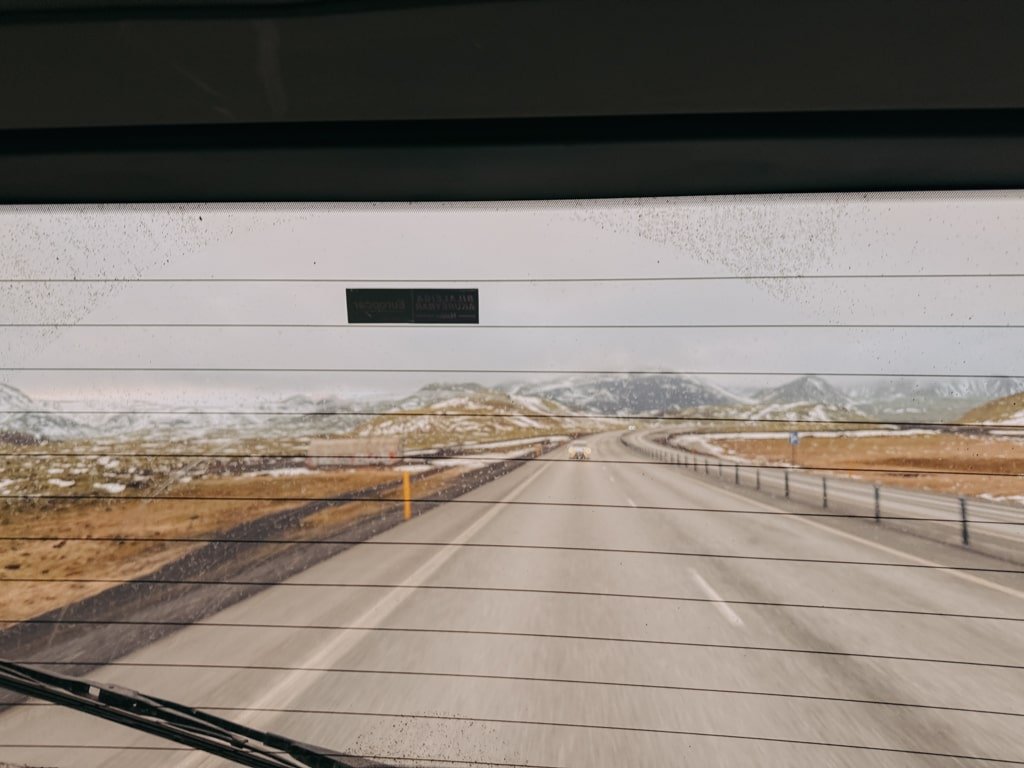
Table of Contents
ToggleWhy is Iceland weather unpredictable
Before we dive into the list, let’s understand why the weather is so unpredictable.
The location of Iceland means it gets cold Arctic air and the warmer air from the Gulf Stream.
It is not uncommon to hear people complain that even summer can mean wind and cold.
With that said, your list will differ a bit depending on whether you pick a winter holiday or a summer holiday.
Quick heads up, this list is for off summer trips in the shoulder season and when the weather can lean colder.
It’s also not for camping related trips but for bus and road trips.
Things to pack for Iceland
1. Bring a checked bag
I know, I know, some of you are carry-on-only warriors. But hear me out: Iceland weather means bulky layers, gear, boots, and extras that take up space. If you’re on a multi-day tour or road trip, having a bit of breathing room in your luggage makes packing (and re-packing) so much less stressful. Unless you are comfortable with buying stuff once you get there, I would suggest giving yourself some more room (literally) to avoid being uncomfortable.
2. Splurge on your rain jacket
This is one of those purchases I debated forever and then finally did it. I splurged on the Arcteryx Beta shell jacket for women this year, and I’m not kidding when I say it changed my entire Iceland trip. It’s lightweight, actually waterproof, breathable, and looks good in photos. The pants followed after that. I did get them a size too big, but hey, they’ll become my partner’s go-to gear now so no regrets.
If you’re going to be standing in wind, mist, rain, and drizzle (which you will), invest in the outer layer. It doesn’t have to be this brand, but don’t settle for fast fashion-style “rain jackets” that soak through in 20 minutes.
The best way to find a deal is outlet stores and summer season discounts.
I had no issue running in and under water when I had this one. Photos below from the amazing glacier walk activity I got to do.
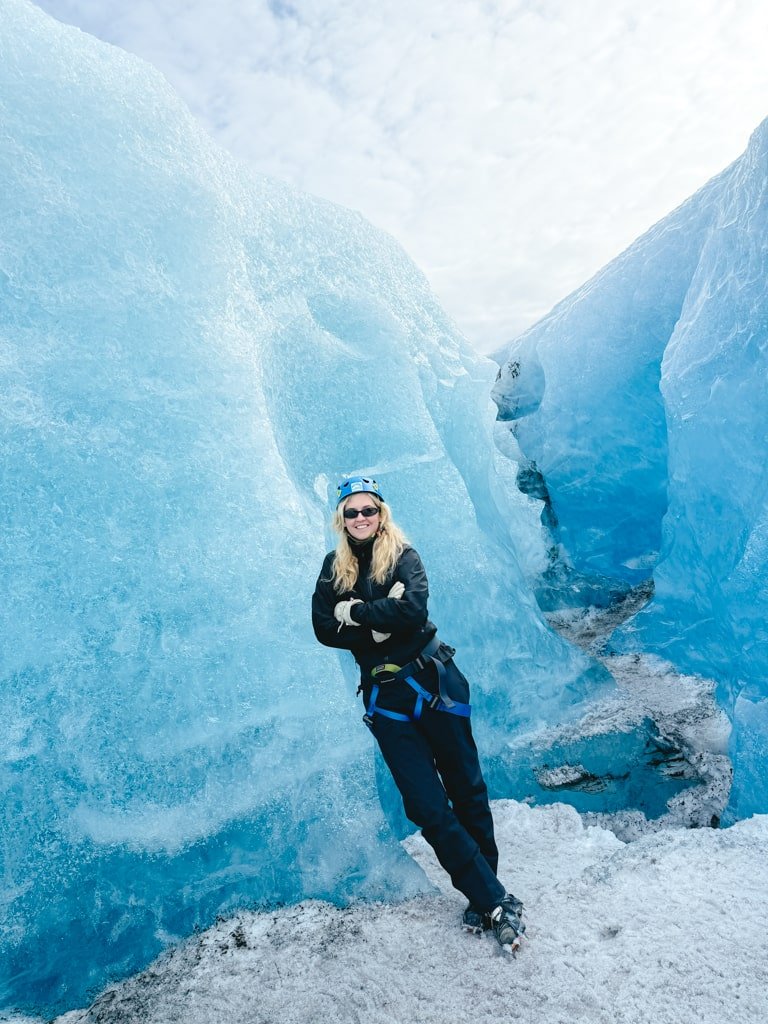
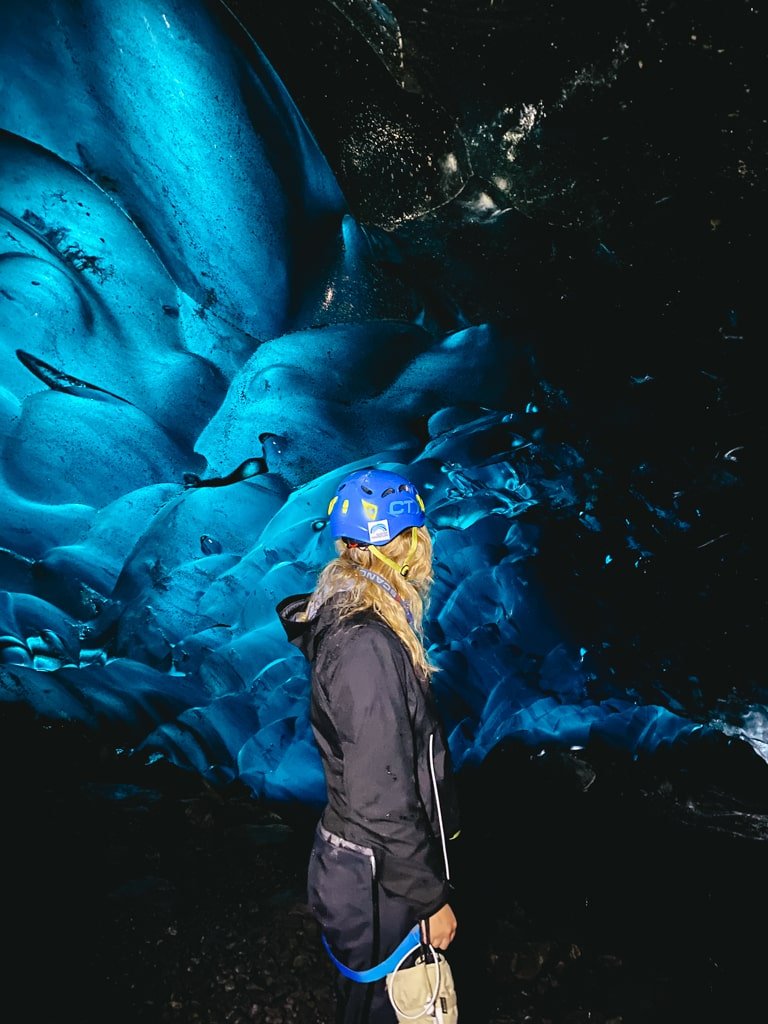
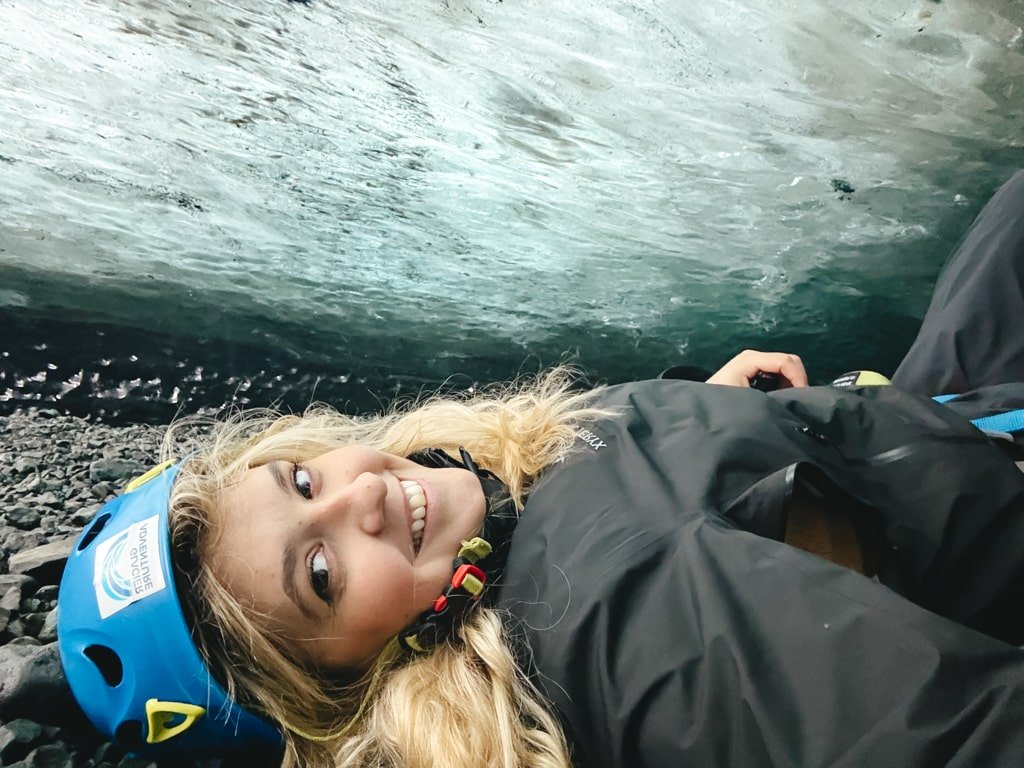
3. Break in your hiking boots
If you’re not very hiking-oriented or outdoorsy in general, make sure you break in your boots before the trip. Some people might think you can just get them and start going, don’t be that person.
You’ll be walking across wet rocks, gravel paths, lava fields, and more. Having sore feet or blisters because your brand-new boots feel like cement blocks is a quick way to ruin a good day.
If you want to break them in, consider wearing them on errands, short hikes, or even just around the house.
I picked up my new Salomon boots a few weeks earlier, but had no issues with them at all. Super classic, affordable and durable.
4. Bring clothes that won’t smell
This is oddly specific, but you’ll be wearing the same base layers, socks, or leggings multiple times. Choose clothes that don’t trap odor too quickly, dry fast, and are easy to wash in a hotel sink if needed.
For me, this includes:
- Merino wool base layers
- A couple of comfy but breathable shirts
- Anti-microbial socks (worth the money!)
- Underwear you can hand-wash and reuse if needed
5. Bring two pairs of shoes
Most countryside accommodations have a space where you leave muddy shoes at the entrance. That’s great until you realize you have no backup shoes and end up walking around in socks, which is what happend to me at some point.
I bring my Salomon hiking boots and a pair of white Birkenstock sandals (sturdy, wipeable, and I won’t cry if they get wrecked). Bonus: they still look decent with socks (just my opinion!).
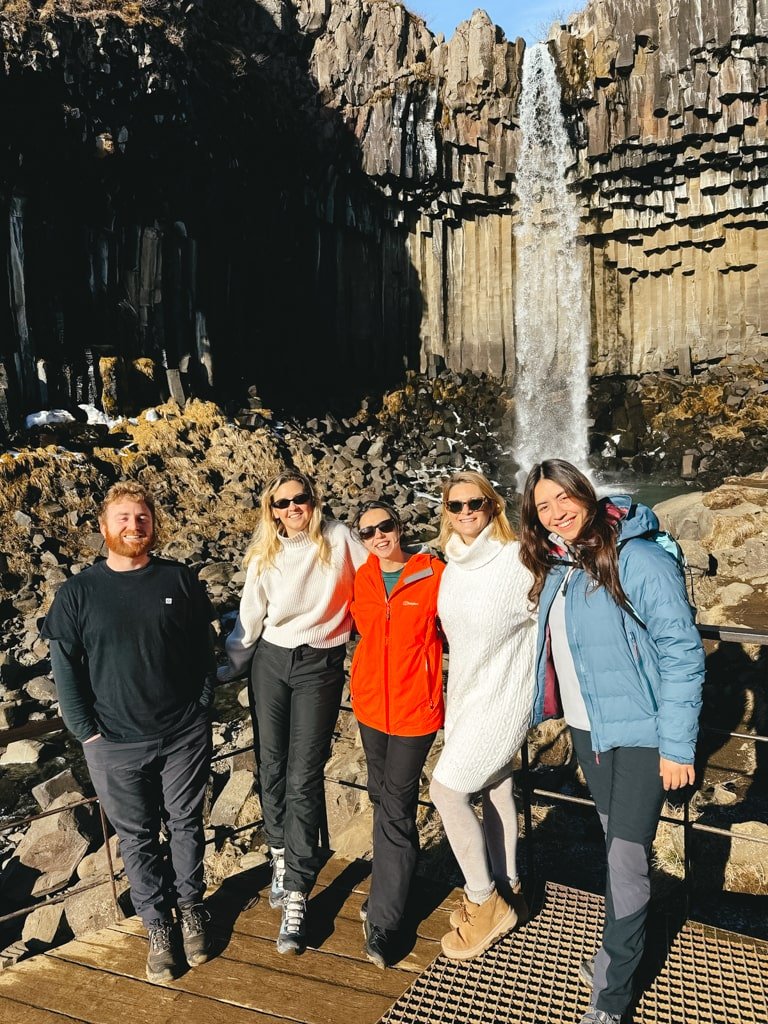
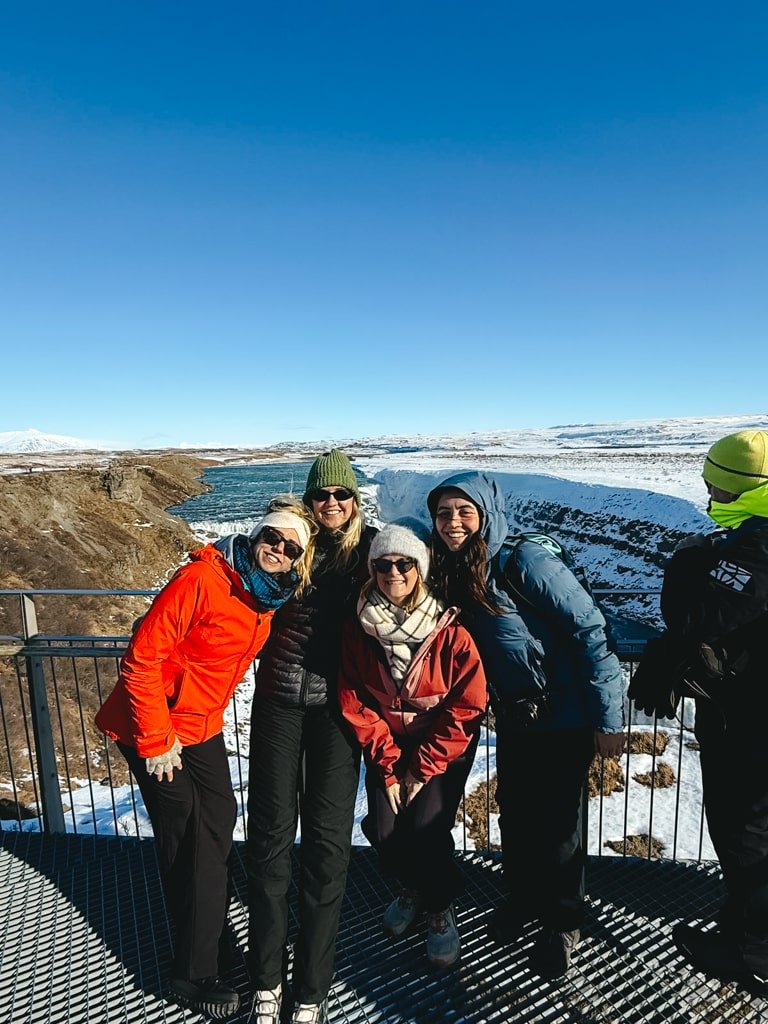
6. Grab a reusable water bottle
Icelandic tap water is amazing. You don’t need to buy plastic bottles just bring your own. Also, buying it will add an unnecessary cost to your budget, that is already high.
If you don’t already have one, pick up a cool design from shops near Vik or check out the famous Icelandic outdoor stores like 66°North or ICEWEAR.
They even sell outlet gear, so you can snag something functional and cute.
7. Consider how your electronics will die from the cold
Cold drains batteries fast. Especially phones and cameras. If you’re going to take lots of photos or rely on Google Maps for your road trip, pack a few power banks and keep them insulated. I’m a core Anker fan and only buy power banks from them. This one will even charge your laptop and it’s still super affordable.
Also, try to avoid leaving your phone exposed to wind and rain for long — or keep it inside your jacket when not in use. You might want to think through a set up that works with your phone (camera) and the gloves you have to wear, while battling rain and cold.
8. Grab a dry bag
Seriously, this is one of the best under-€10 items you can bring. A dry bag takes up no space but will save your gear on rainy hikes, near waterfalls, or even just during a misty walk to the bus. You can also use it to separate dirty/wet clothes on travel days and to put in wet gear while you’re on the bus. If you want to plan ahead, a 3-pack in different sizes will last you years. I usually go for Sea to Summit.
if you don’t bring a dry bag, then at least grab some rubbish bags to have available.
9. Bring a nicer outfit
Reykjavik is a bit fancy. Even with wind and sideways rain, people there dress to impress. So, if your itinerary includes more time in the city or a nice dinner out, bring one or two outfits that feel a little more “put together.”
This can be as simple as:
- Jeans and a stylish knit
- A nicer coat or trench
- Your good boots cleaned up a bit
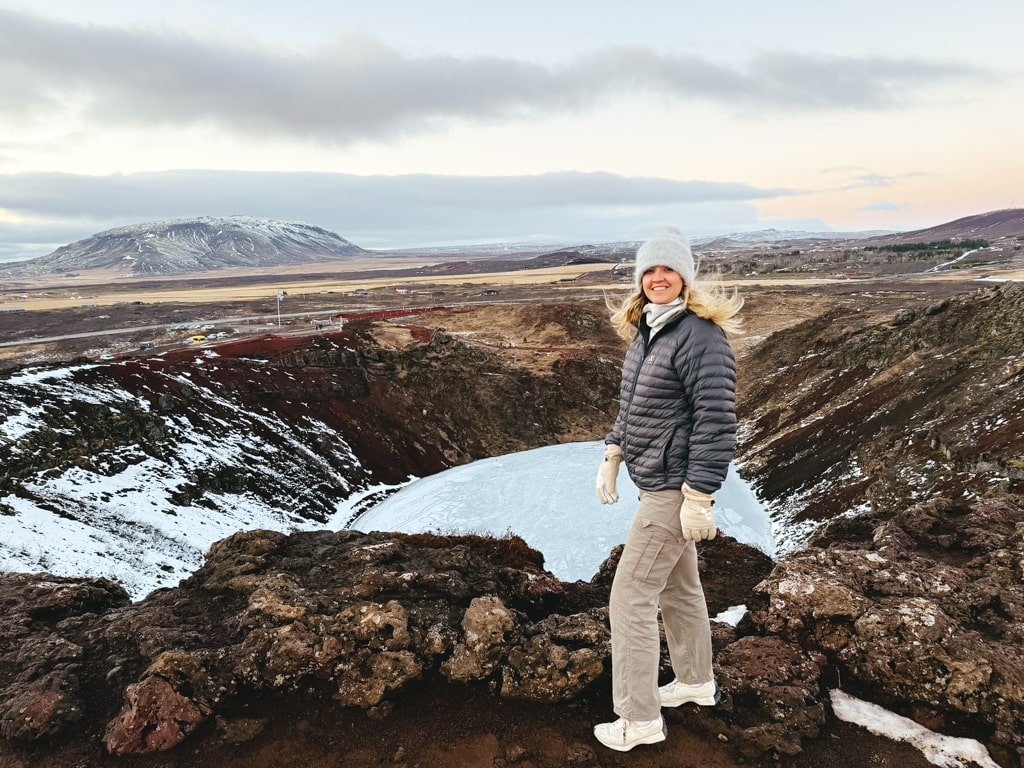
10. Put together a bus ride kit
You’ll be in and out of the bus all day, in rain, wind, and drizzle. Then you’re back inside, trying to warm up and stay dry. This constant change from stepping out into the rain, to coming back into the bus wet and wanting to dry, to having to go out again, can get a bit tiring.
I had:
- A fleece I wore only inside the bus
- A rain shell for quick throw-on moments
- A beanie and waterproof gloves
- Dry socks to change into immediately
This system saved me from getting sick or skipping stops due to being wet and cold.
11. Bring two pairs of gloves
This might be my preference, but the fastest way for me to get cold is to have cold hands. So bring a thick pair of proper winter gloves if the temperature is low (autumn, winter, spring) and an extra pair for when you get indoors and you want to warm up your fingers.
12. Must-have toiletries
In addition to your normal toiletries, you might want to grab some extra care stuff for the wind, rain and cold.
For me, this is a Paw Paw ointment by Lucas (NZ classic) cause my lips will crack and bleed instantly. You might also want to grab some extra wet wipes and tissues if your eyes water from the wind or you get a runny nose. Trust me this was such an annoying thing when you are out in the wind all the time. Since you probably will visit a thermal spa location at least once, consider a small quick dry towel for that part of the trip.
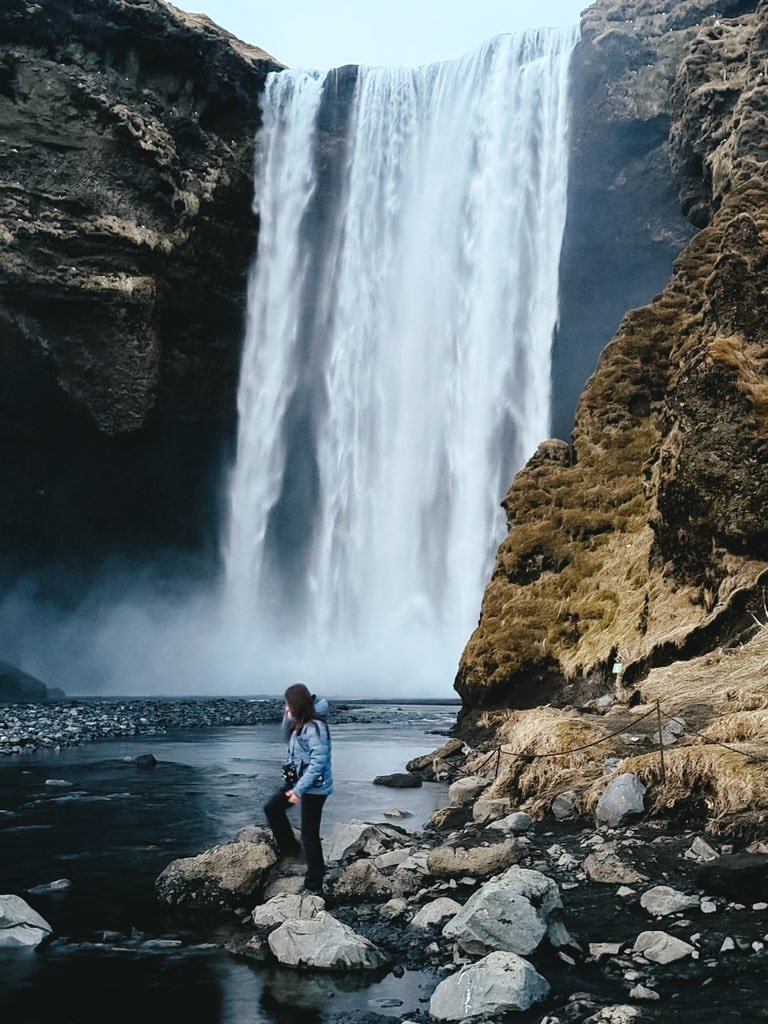
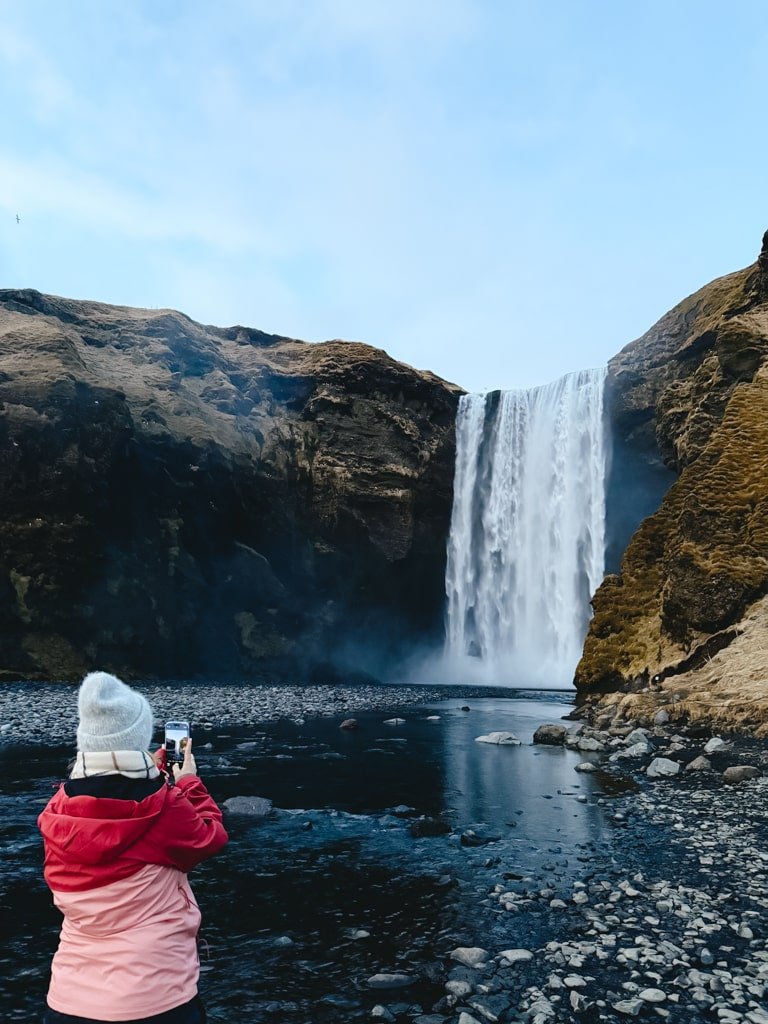
13. Put extra socks + deodorant in your day bag
If your boots get soaked (which they probably will), have a pair of dry socks ready. Changing socks before a long bus ride is awesome and you will have to do it often. You don’t have to spend a fortune on socks, but you’ll have to shop ahead and buy online most times. (my experience). Merrell have great wool socks in multi-packs that you can grab online in different colors.
Also, if you’re changing in and out of boots a lot, things can get a bit funky. Bring deodorant or wet wipes to freshen up.
14. Don’t stress too much about an umbrella
Hot take: umbrellas are mostly useless in Iceland. The wind is just too strong most days. I brought a sturdy one and used it maybe twice.
Focus on rain shells with hoods, waterproof backpacks, and layering instead.
15. Don’t only pack one swimsuit
If you’re planning to visit more than one thermal pool (and trust me, you’ll want to), bring two swimsuits. No one enjoys putting on a cold, wet suit for round two.
Speaking of pools, while the Blue Lagoon is the most famous and photogenic, I personally prefer the lesser-known thermal spots and local spas that feel more relaxed and affordable. That said, I did try the Sky Lagoon this time and genuinely loved the experience, the setting is beautiful, and it feels like a solid middle ground between local and luxury.
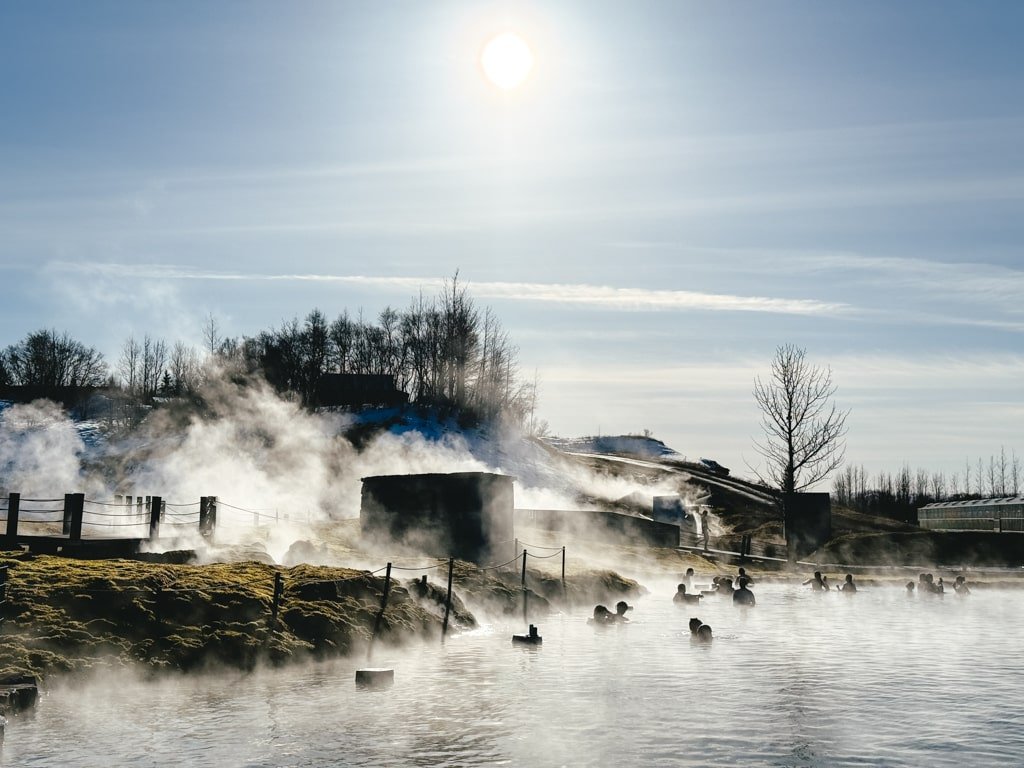
16. Don’t forget sunglasses
I feel like I wouldn’t have survived the glacier walk Ι did in Iceland without proper sunglasses. Even in cold weather, the glare from the ice and snow is intense, and if your eyes are sensitive like mine, it’s not something you want to overlook.
Bring at least one good-quality pair, or if you tend to lose things (guilty), pack a backup or a cheaper pair you won’t cry over if they fall into a waterfall or vanish under a bus seat.
What to pack or buy there?
Iceland has great outdoor stores (like 66°North, ICEWEAR, and outlets in Reykjavik), but prices can be high. Unless you plan to invest in good quality gear, it’s better to buy the basics at home.
That said:
- You can buy a reusable bottle, buff/neck warmer, or gloves locally if you forget
- Outdoor outlets near Vik and Reykjavik often have great deals and you can pick up an item that doubles as a souvenir (go for something with an Icelandic design).

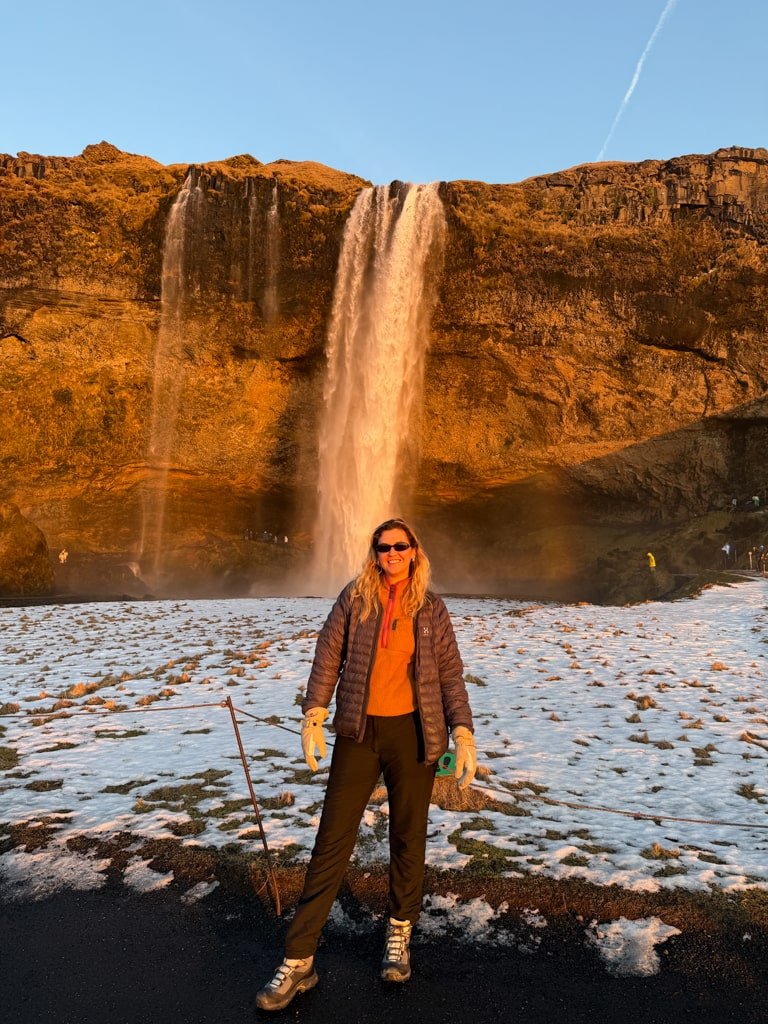
Other stuff
A headlamp or flashlight
If you’re doing any early morning or nighttime activities, staying in hostels, guesthouses, or shared cabins, or just want a more reliable option than your phone, a small headlamp or flashlight is a great addition. Iceland isn’t the best-lit place once you leave the city.
Don’t expect to be able to do laundry
Unless you’re staying at a nicer hotel and are happy to pay some money, doing laundry at a laundromat is quite hard to find. Instead, you’ll have to wash and dry things the DIY way. For that purpose, bring some soap or washer sheets with you to be able to do laundry at a location you can wait longer at for things to dry.
Essential Apps for Iceland
These are the apps I always download when heading to Iceland:
- SafeTravel – run by the Icelandic search and rescue teams. Good for route planning and updates.
- 112 Iceland – an emergency app that lets you check in with your location even without mobile signal.
- Vedur – Iceland’s official weather app. Super useful when you’re trying to plan your day around wind and road conditions. Apple and Android weather apps are less reliable here.
- My Aurora Forecast – if you’re visiting in Northern Lights season, this app gives you a good prediction window (but take it with a grain of salt). With that said, I did see the lights when it said I would!
Camera and Photography Gear
I’ve honestly become a lot less focused on photography gear the past few years — mostly because work travel doesn’t allow for many slow or scenic stops anymore.
That said, here’s what I still bring and recommend if you’re planning to capture your trip:
- Fujifilm X100 – my trusty mirrorless camera that’s definitely seen better days but still gets the job done. I think this camera is going over 10 years strong!
- GoPro Hero 12 – perfect for Iceland. Whether you’re hiking in the rain, driving through windstorms, or capturing glacier lagoon scenes, it’s a no-fuss, weather-resistant option.
- A small tripod (especially for waterfall photos or Northern Lights)
- Extra storage cards
- Extra batteries or power banks (cold weather drains them fast)
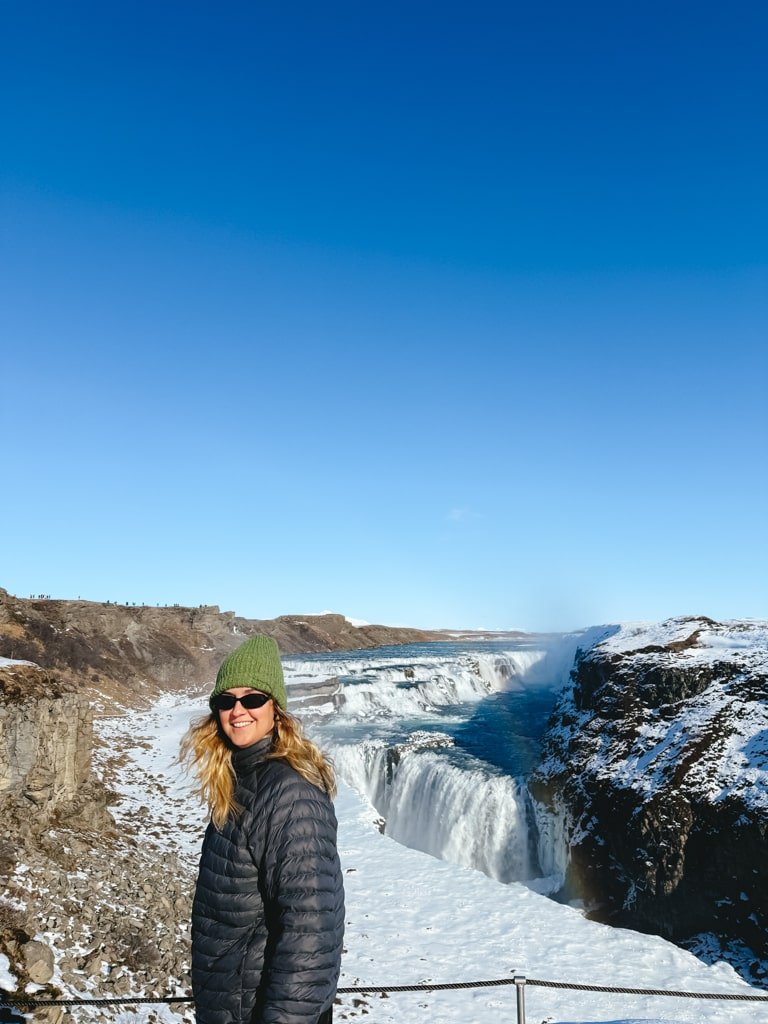
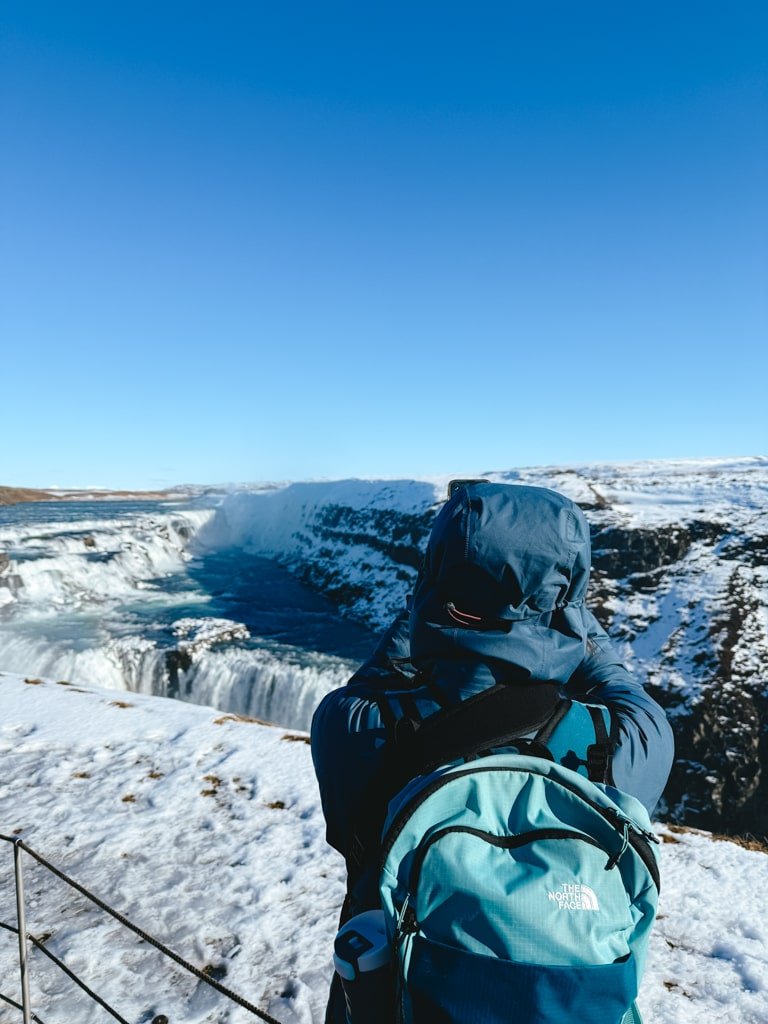
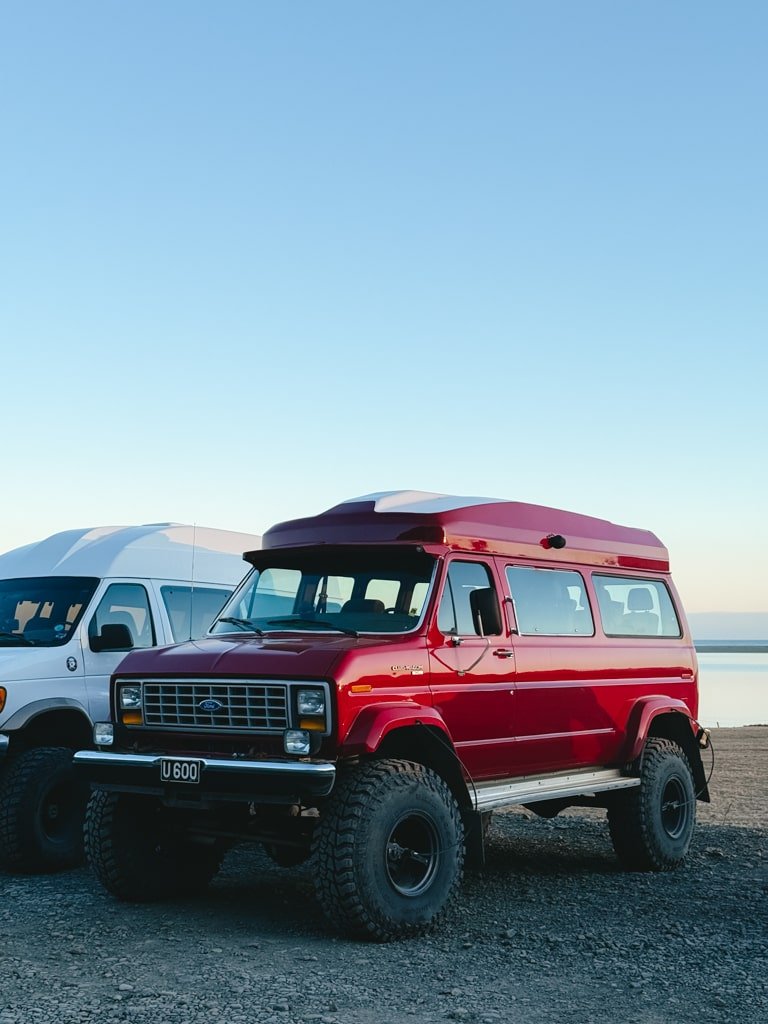
Medication (Don’t skip this!)
I messed up this time and didn’t bring my full personal kit and it reminded me how spaced out pharmacies are in Iceland, and how many meds require a prescription. I would highly recommend packing your own basics.
Here’s what I always travel with now:
- Imodium (trust me, always have it)
- Allergy meds – I had a small reaction in Greece recently and since then, I don’t travel without some antihistamines
- Blister pads – you don’t want to be breaking in boots without them. Also much cheaper to buy online usually.
- Painkillers and plasters
- Hand warmers – these are a game-changer when your fingers or toes freeze. I bought a bulk pack and keep them for every trip now. Also a must if you’re travelling with kids.
Other things to keep in mind
- Adapter – Iceland uses the European plug (type C/F). If you’re visiting from the UK, US, or elsewhere, bring a universal adapter or grab one at the airport.
- Some cash – Iceland is almost fully card-based, but I like having a bit of cash on hand for tipping or small countryside purchases.
- Credit card or Revolut – I mostly use my credit card for points, or my Revolut EU account for good conversion rates.
Mobile Data + SIM Options
I hate not having internet on trips — especially work trips. As an EU traveler, my phone plan covers me, but if yours doesn’t, definitely consider:
- Buying an eSIM before you travel
- Picking up a local SIM in Reykjavík
- Making sure you have enough data to use Google Maps and check weather conditions on the go
While I didn’t get to use one in Iceland, I did trial a few companies in my 25 days in Korea and a recent trip to Turkey and New Zealand.
I’ve narrowed it down to a few companies, Airalo and Yesim and also had a few I cancelled straght away that I won’t mention. Check them out to see what package data rates they offer before you decide.
I always go for an unlimited data plan (I need to know it is always available to me). At the moment both companies offer unlimited data plans around the same price.

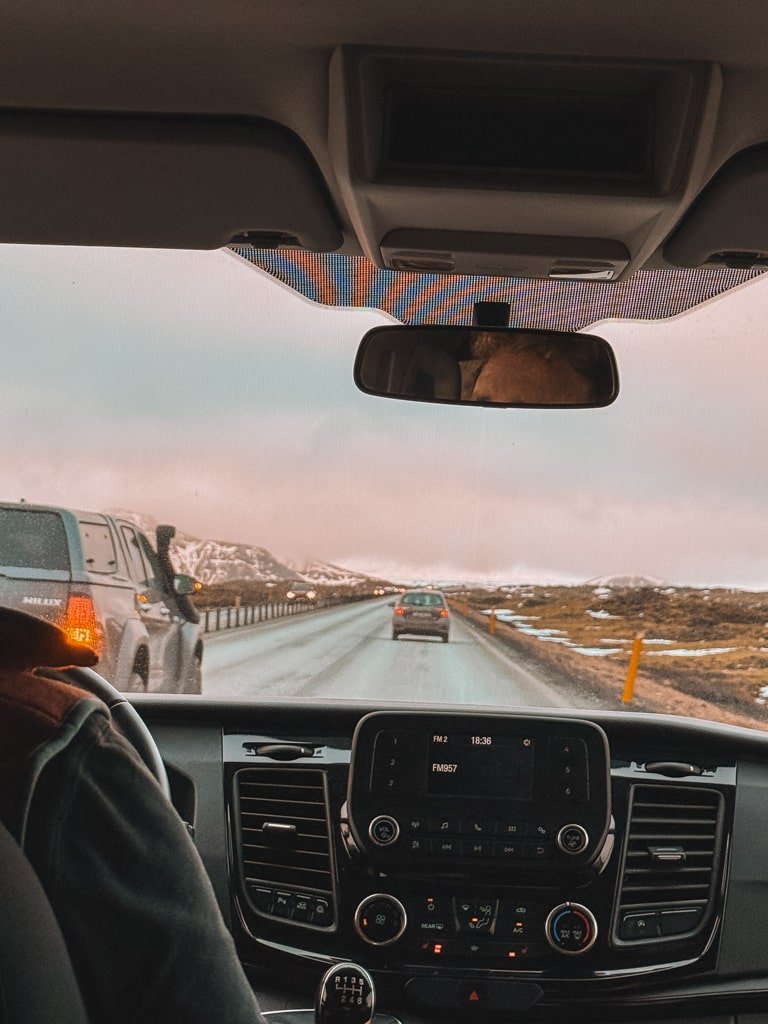
What Not to Pack: Mistakes to Avoid
It’s easy to overpack for Iceland especially when every video or blog screams “waterproof everything!” but here are a few things you don’t need to bring (or at least not overdo):
1. Too many “nice” outfits
Unless you’re staying in Reykjavík the whole time or planning fancy dinners, you’ll likely be in outdoor clothes 90% of the time. Iceland is casual, even locals wear hiking gear to cafes. Bring one nice outfit and leave the rest.
2. An umbrella
Seriously, don’t bother. Icelandic wind will eat your umbrella and spit it out on the Ring Road. A proper rain jacket (with a hood that stays up) will do far more for you than any umbrella ever could.
3. Over-the-top makeup or hair tools
Humidity, rain, and wind don’t care how much effort you put in. A small toiletry bag with essentials is fine, but your curling iron, full-size hair dryer, and makeup palette can stay home. I mostly leaned on dry shampoo, a good head cover or hair accessories to keep hair out of the wind, a bit of mascara and concealer and some lip protection.
4. Fancy shoes or heels
Nope. Just… no. Stick with your boots, sneakers, and maybe a pair of sandals/slides for indoors. Anything else will just take up space.
5. Books and heavy travel guides
This is mostly a space issue and a weight issue. But of course, preferences take priority here. For me, I travel with a Kindle or my phone and also managed to grab a book from a local author that I read during my time there. It’s called the Night Guest and it’s a short and easy read, with mystery and a great sense of place and setting so you feel like you learn a bit about Iceland as well. You might also want to check out some films and tv-series to get you excited about the locations like Katla or Entrapped
ESSENTIAL INFORMATION
Must Know When Visiting Iceland
- Emergency: Dial 112 for police, fire, or ambulance — it’s a unified emergency service.
- Language: Icelandic is the official language, but English is widely spoken, especially in Reykjavík and tourist-friendly areas. Still, it’s nice to know “Takk” (Thank you) and “Hæ” (Hi).
- Water: Tap water is 100% safe and delicious skip bottled water entirely.
- Driving: Drive on the right-hand side. Renting a car? A 4×4 is recommended in winter. Check road.is and safetravel.is before heading out.
- Accommodation: Use Booking.com or Airbnb for the widest range. Hostels, farm stays, and guesthouses are also popular. Always book early, especially in summer.
- Weather: Icelandic weather changes fast always check forecasts at vedur.is or download the Vedur app. Wind and rain can pick up without warning. Check out the packing guide for more info.
- Activities: From cultural sights to day trips, food tours and city guides, use Get Your Guide.
Public Transport: Limited outside Reykjavík. Use Straeto buses in Reykjavík, or plan ahead for long-distance routes — but self-drive or guided tours are far more practical.
- Domestic Airlines: For islands like the Westman Islands, ferries can be booked via Herjólfur. For longer distances, look at Icelandair or Eagle Air for domestic flights.
- Taxi: Taxis are expensive and not always available. Use them only if needed or ask your hotel to call one. No Uber or rideshare services exist.
- Money: Credit and debit cards are accepted everywhere, including for tiny purchases. No need for cash in most cases.
Culture: Icelanders are friendly but value personal space. Tipping isn’t expected. Pools have strict hygiene rules (you must shower naked before entering), and hot springs are seen as a shared cultural experience not just a tourist activity.

